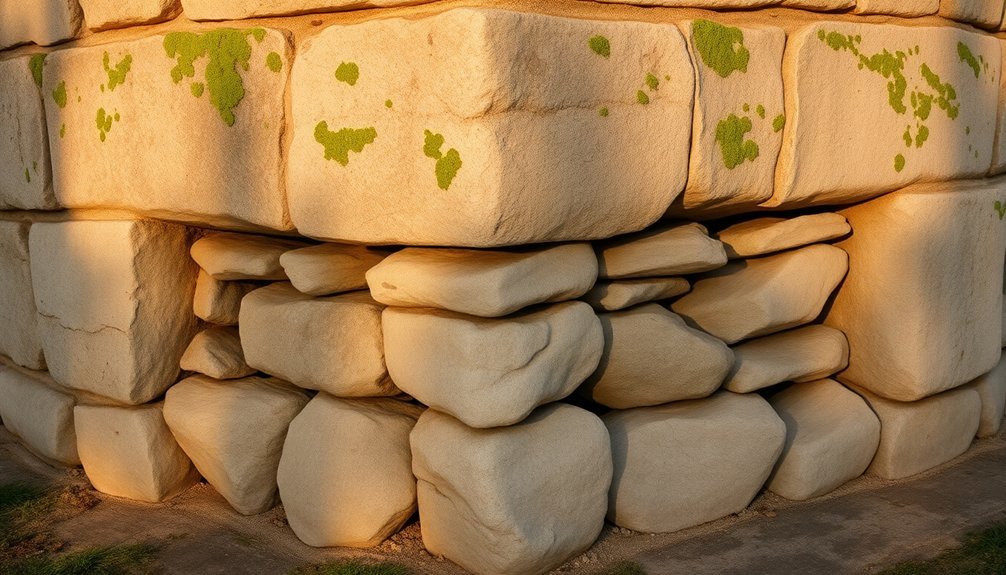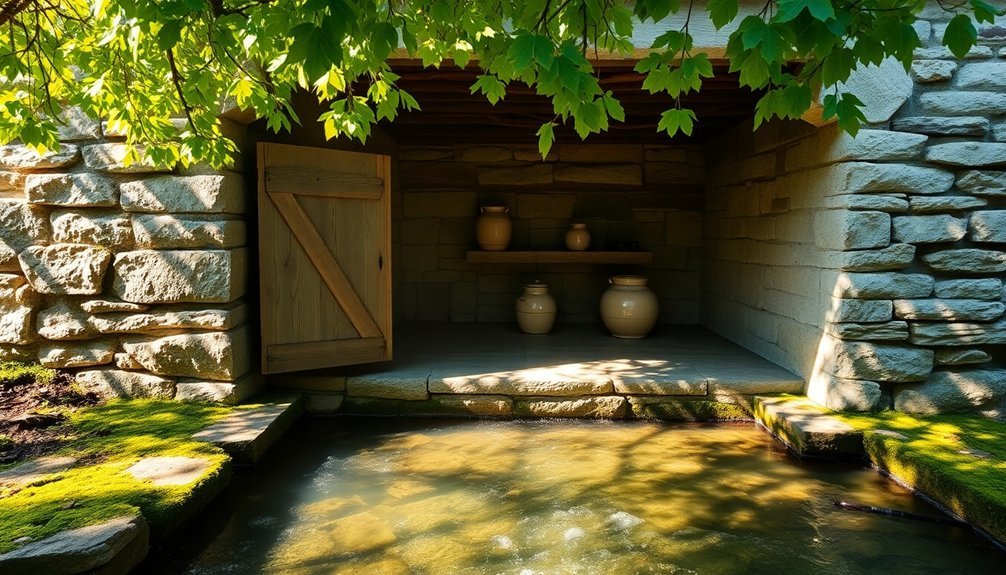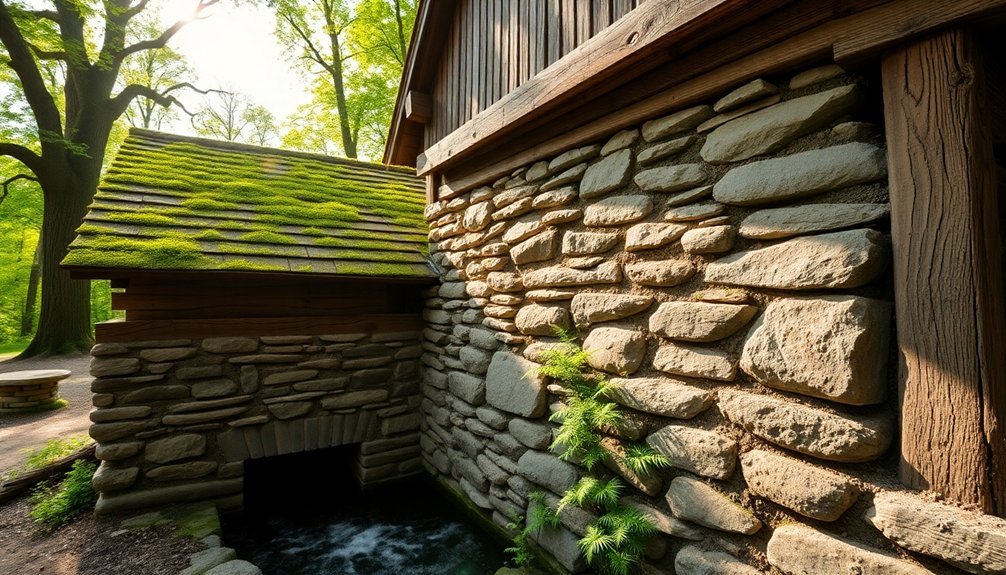Colonial spring houses relied on three key construction secrets you'll find invaluable today. First, you'll want to select rough-cut fieldstone or limestone that matches your local geology, ensuring both durability and natural insulation. Second, build directly over your spring source while engineering a strategic water channel system with gravel filtration and proper gradient for ideal flow. Third, construct your spring house into a hillside with thick stone walls and separate zones for different temperature needs – just like a modern heat pump system. These time-tested techniques hold the key to creating your own naturally-cooled storage solution.
Stone Selection For Lasting Durability

Three key factors guided colonial builders in selecting stones for their springhouses: durability, availability, and geological compatibility.
You'll want to follow their time-tested wisdom by choosing stones that can withstand weathering and erosion, particularly fieldstone and limestone, which have proven their resilience over centuries.
When selecting your stone, you'll need to take into account what's readily available in your region. Using local stone not only reduces construction costs but guarantees your springhouse blends naturally with the surrounding landscape.
If you're in Rhode Island or southern Massachusetts, limestone's your best bet, while other regions might favor abundant fieldstone. Early settlers always built their homes near reliable springs first.
Remember to match your stone selection with existing structures on your property. You don't want your springhouse to look out of place.
If you're working on a restoration project, you'll need to be particularly mindful of historical accuracy – choose stones that match the period and style of the original structure.
For the best results, use rough-cut stones that maintain authenticity while providing the necessary structural integrity.
Your stone selection will greatly impact both the durability and aesthetic appeal of your springhouse for generations to come.
Water Channel Engineering Methods
Mastering water channel engineering in your spring house begins with proper utilization of the natural spring flow. You'll need to build directly over the spring and create a small pool within the channel that's deep enough to accommodate large containers. The water should flow through this pool and exit through a designated opening.
Logical reasoning suggests maintaining precise measurements and gradients throughout construction. You'll want to lay gravel and stones strategically throughout the channel. This isn't just for filtration – it's essential for preventing erosion and maintaining the channel's structural integrity over time.
Make certain you're creating a path that allows water to flow smoothly through the spring house and toward your desired destination, whether that's a stream or another water feature.
For peak performance, you'll need to calculate the proper fall in your channel. Consider incorporating perforated pipes wrapped in stone to give water the path of least resistance.
Don't forget to use landscape fabric to keep soil and debris from entering your system. When you're laying the stones, use no. 57 stone both above and below your pipes to guarantee proper drainage and prevent clogging.
This careful engineering will make sure your spring house functions efficiently for years to come.
Optimal Temperature Control Design

Creating an ideal temperature-controlled spring house requires strategic placement and thoughtful design choices. You'll want to build into a hillside, taking advantage of the earth's natural insulation properties while positioning the structure to maximize shade coverage throughout the day. The presence of active springs provides a constant source of cold water, essential for maintaining lower temperatures. Similar to modern multi-zone heat pumps, this design allows for precise temperature control in different areas.
For best cooling, you'll need to construct the walls using stone masonry, which naturally maintains cool temperatures. Install stone or metal hooks and ledges to keep stored items off the ground, and incorporate earthenware containers for food storage.
You can enhance temperature control by designing separate rooms for different activities, allowing better management of air circulation. Your ventilation strategy should include an open door design and strategically placed windows on upper levels.
For maximum efficiency, create storage areas that allow items to remain partially submerged in cold water. When building the second floor, you'll find it serves as an excellent space for drier storage while helping to reduce moisture accumulation below.
Consider adding a fireplace for temperature regulation during colder months.
Frequently Asked Questions
How Did Colonists Protect Spring Houses From Wild Animals and Intruders?
You'll protect your spring house by building it with solid stone walls, securing entrances with heavy doors, positioning it strategically on high ground, and maintaining clear surroundings to deter both wild animals and intruders.
What Traditional Herbs Were Planted Around Spring Houses to Deter Insects?
You'd want to plant mint, lavender, rosemary, and thyme around your spring house. These herbs naturally repel mosquitoes and other pests, while mint and lavender also keep away moths and flies.
How Were Spring Houses Modified During Harsh Winter Conditions?
You'll want to insulate your spring house by adding extra straw around exposed walls, covering water channels with wooden planks, and packing snow against exterior walls for additional protection during winter months.
Did Spring Houses Serve Any Social or Community Gathering Purposes?
While spring houses weren't primarily social spaces, you'll find they were part of farms where community gatherings occurred. They supported daily tasks like dairy work, which naturally brought neighbors together for informal social interactions.
What Spiritual or Cultural Significance Did Spring Houses Hold for Colonial Settlers?
You'll find that spring houses held deep spiritual meaning for colonists, serving as safe havens during war, places for sacred rituals like blessing newborns, and symbols of divine providence through their life-sustaining water supply.
In Summary
You've now mastered the key elements that made colonial spring houses endure for centuries. By selecting the right foundation stones, engineering precise water channels, and implementing smart temperature control systems, you'll be able to build a spring house that stands the test of time. Whether you're preserving history or creating a new structure, these traditional techniques will help you achieve authentic, lasting results.





Leave a Reply